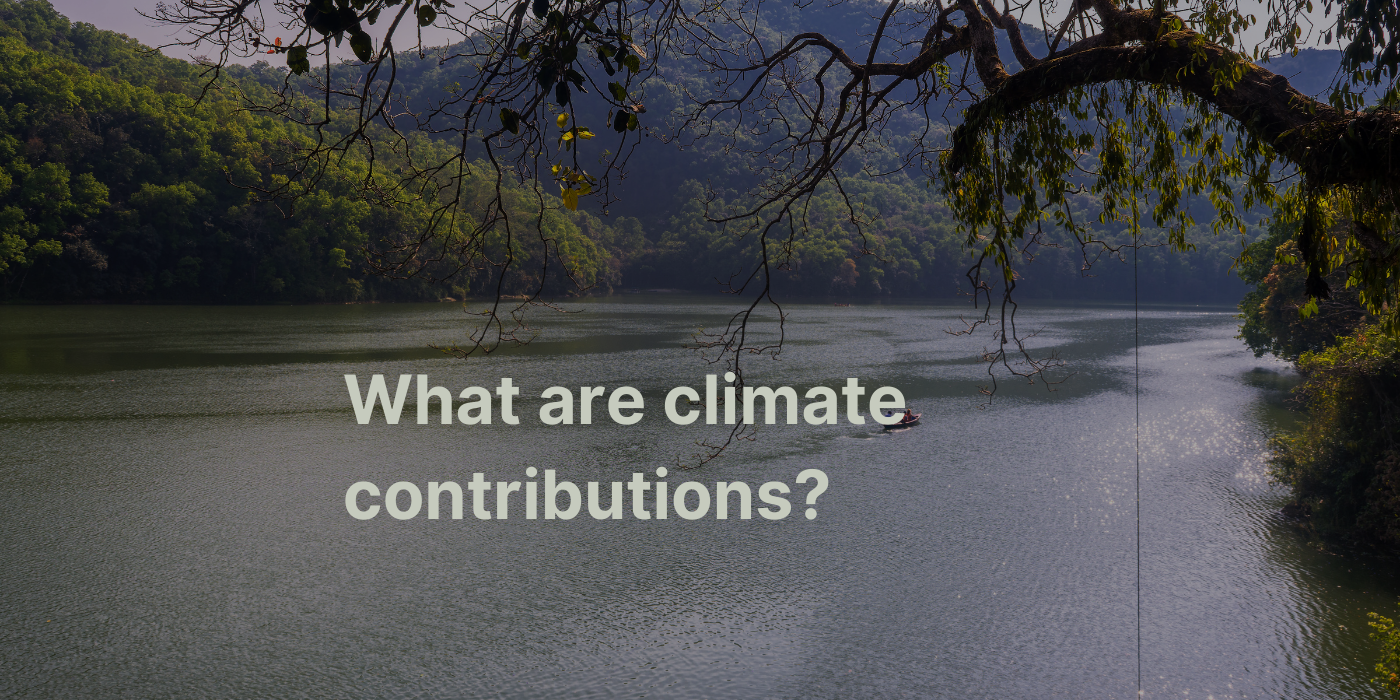What are climate contributions?
Climate contributions are an emerging area of climate action. We look at what they are and how they differ from carbon credits.

Climate contributions are emerging as a new tool to help organizations achieve credible, high-integrity net-zero targets.
In this post, we explore:
- What is a climate contribution?
- How does it differ from carbon credits?
- Advantages of climate contributions
- What do climate contributions currently look like?
- How can blockchain support climate contributions?
What is a climate contribution?
Companies are increasingly making ‘net-zero’ carbon claims in relation to their climate action ambitions. But carbon offsetting has recently come under increased scrutiny, and there are issues related to how credible these claims are.
Simultaneously, climate contributions are surfacing as an emerging area of corporate climate action. They encompass all climate investments made beyond reducing and compensating a firm's own emissions.
Climate contributions enable corporations to contribute directly to global carbon reduction and net-zero efforts by financing climate projects. The resulting impacts are counting towards national climate targets, instead of their own carbon footprint.
The Science Based Targets initiative (SBTi) is leading the way in guiding companies on how to utilize climate contributions effectively, referring to them as “beyond value chain mitigation” (BVCM). They detail that contributions should complement a firm’s internal climate targets. This means that they do not replace the need for a firm to calculate their own carbon footprint, and they prioritize action to reduce this first. Reducing the carbon footprint involves minimizing scope 1 and 2 emissions, and using carbon credits to compensate for scope 3 emissions.
In the shorter term, climate contributions will likely focus on financing carbon avoidance projects and investing in early-stage carbon removal projects. They can also include investment in a broader range of climate projects and charitable contributions. In the longer term, firms will likely directly finance carbon removal credits in line with the Oxford Principles for Net-Zero. The voluntary carbon market will therefore still play a role in relation to purchasing and offsetting credits used, as well as for climate contributions.
Advantages of climate contributions
There are several advantages of making climate contributions instead of looking towards traditional carbon offsetting.
- Climate contributions enable a more rounded approach to climate action. They constitute a broader range of investments, donations, or policy engagement beyond carbon reduction.
- Contributions can be used to support carbon avoidance and removal projects in the global North. This enables investments in innovative, restorative projects in Europe and the US, while the majority of carbon credits are concentrated in the global South.
- Contributions are more flexible than the requirement to offset value chain carbon emissions. Firms can openly select the type of climate action they support and the amount of money they want to spend.
- Companies are less exposed to accusations of greenwashing. This is because firms will not use these contributions to claim carbon neutrality. Additionally, the validity of more diverse contributions will not be affected by the issues of transparency that afflict the voluntary carbon market.
- Contribution claims avoid the accounting challenge related to Article 6 of the Paris agreement: All countries can now claim carbon credits against their national climate contribution. This blurs the line between voluntary and compliance carbon markets, and could lead tocarbon credits being counted twice.
What do climate contributions currently look like?
The use of climate contributions is just beginning to emerge. Guidance on how action should look like is still being developed by the SBTi.
A growing area of activity are investments by firms into currently expensive carbon removal solutions. Here are some examples:
- Klarna plans to invest in 20 early carbon removal projects using a $2.35m fund that was raised using an internal carbon tax.
- Frontier is a consortium of firms seeking to make an advanced market commitment of $1b of permanent carbon removal by 2030. They recently committed to supporting Charm Industrial, spending $53 million to remove 112,000 tonnes of CO2 by 2030. While this investment may eventually produce credits used to offset company emissions, the initial aim is to fund early-stage solutions that may never be verified as viable credits.
These developments are encouraging, but there remains a lag in accompanying regulations around climate contributions. To begin to remedy this, carbon registry Gold Standard recently announced a consortium that will create guidance around BVCM commitments. This will help keep companies' contributions using carbon credits in line with the Science Based Targets Initiative.
How can blockchains support climate contributions?
Blockchains are useful tools that can be leveraged in several ways:
- Climate contributions can be tokenized and transparently recorded on a publicly accessible ledger. This would avoid issues of opacity afflicting the voluntary carbon market in relation to climate impact.
- Tokenized contribution claims are compatible with ongoing digital monitoring, reporting, and verification (dMRV) data. This means that impact can be backed with timely, high-quality information as it becomes available.
- Small, early-stage climate projects using new methodologies would become more accessible and visible, which could help increase advanced market commitments. This will make it easier to identify high-integrity projects and send strong market demand signals.
- Engagement with Web3 projects can drive new demand sources for advanced market commitments, i.e. by using decentralized finance mechanisms. An innovative example is Solid World’s development of a forward market for high-integrity mangrove restoration projects.
- Via smart contract technology, climate contributions can automatically be certified once certain parameters are met. This reduces the time and resources needed to verify the delivery of climate impacts.
Toucan is building technology to unlock climate action at scale. Our digital infrastructure is helping to grow the voluntary carbon market (VCM) in a transparent and high-integrity way. It increases the flow of revenue to the most effective climate impact projects, by bringing established and nascent environmental assets on the blockchain.

